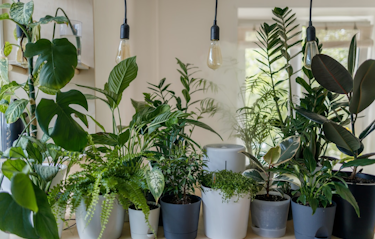
How To Trim Pothos
- Easy Care
- Araceae
- Large
- Evergreen Tropical Vines
We independently select everything we recommend. When you buy through our links, we may earn a commission.
ZZ plants, (Zamioculcas zamiifolia), are tropical perennials that grow from rhizomes, underground stems that produce roots and shoots. With proper care, ZZ plants can grow up to three feet tall and wide, and may produce small, cone-shaped flowers.
Published on 08 September, 2023 by Ash Read
ZZ plants have thick stems and glossy, dark green leaves capable of storing water for extended periods, making them an excellent choice for those prone to forgetful watering habits.
They are known to be slow growing but can reach up to three feet in ideal conditions. They can thrive in low-light environments, making them a perfect choice for indoor gardening.
While ZZ plants are often compared to other popular indoor plants like peace lilies, raven plants, philodendrons, and snake plants, they are quite distinct in appearance. They are often called the "aroid palm" due to their palm-like appearance.
The ZZ plant, also known as Zamioculcas zamiifolia or Zanzibar Gem, is a tropical perennial plant that grows from rhizomes.
Rhizomes are underground stems that store water and food. They grow horizontally and produce roots and shoots at intervals, allowing the plant to spread and establish new growth.
While ZZ plants also have leaves that store water and nutrients, which technically categorizes them as succulents as well.
This adaptation makes ZZ plants drought-tolerant and allows them to survive dry and low-light conditions.
These leaves are compound, comprising several smaller leaflets attached to a single central stem. The combination of hardiness and attractive appearance has made the ZZ plant popular among houseplant enthusiasts.

ZZ plants can reproduce in several ways.
One standard method is through division, where the plant is carefully removed from its pot and divided into two or more sections, each with a portion of the rhizome and foliage. This is often done during repotting to create new plants or to rejuvenate an older specimen.
Another method of propagation is through leaf cuttings. To propagate a ZZ plant from a leaf, select a healthy leaf and cut it into sections with a sterilized knife or scissors. Place the leaf sections in a pot filled with well-draining soil and keep it moist but not too wet. After a few weeks, new roots and shoots should begin to emerge from the base of the leaf.
If your plant needs pruning to shape it or control growth, save the stem cuttings, which are easily rooted in water. When the roots are about three inches long, transfer the cutting into a pot with well-draining soil and place it in an area where it gets bright, indirect light.
ZZ plants can also grow new stems from the base of the parent plant. As the rhizome expands, new stems emerge from the soil. These stems can be separated from the parent plant and potted individually to create new plants.

The ZZ plant is considered a relatively slow grower compared to other indoor plants. However, it can still grow to be quite large over time if given the right conditions:
While ZZ plants can tolerate low light conditions, they will grow quickly and produce more foliage in bright indirect light. Place the plant near a window with plenty of light, but avoid direct sunlight.
Keep the plant slightly dry, and allow the soil to dry out partially between waterings. Under-watering and over-watering can lead to root rot, leaf drop, and other problems, so it's essential to ensure good drainage and avoid leaving the plant in standing water. Pots with large drainage holes are suitable.
A ZZ plant doesn't require frequent fertilization, but you can encourage growth by fertilizing the plant once a month during the growing season with a balanced, water-soluble liquid fertilizer.
These tropical perennials thrive in warm, humid conditions, so maintaining a temperature range between 65 and 75°F (18 to 24°C) and relative humidity of around 40 to 50% can help promote growth.
ZZ plants can benefit from repotting every 1 to 2 years to provide fresh potting soil and room for growth. Choose a well-draining potting mix with perlite and a container slightly larger than the current one, then gently loosen the plant's roots and transfer it to the new pot.
Remove dead, damaged, mushy, or yellow leaves to keep the plant healthy. Use clean, sharp pruning shears to make a clean cut at the base of the affected leaf.
Watch for aphid infestations or other pests and quickly treat the plant to prevent damage.

ZZ plants offer several practical and aesthetic benefits, including air purification, low maintenance, drought tolerance, and easy propagation.
A ZZ plant can live for up to 15 years or more with good plant care and ideal growing conditions. However, the growth rate of ZZ plants is relatively slow, so it may take several years to reach their maximum height and size.
Yes, ZZ plants are toxic to humans and pets if ingested. They contain calcium oxalate crystals, which cause skin irritation, itching, and redness upon contact. If the plant is ingested, it can cause nausea, vomiting, and diarrhea.
There is no difference between a ZZ plant and a ZZ houseplant as they refer to the same plant species, Zamioculcas zamiifolia. ZZ houseplants are only indoor plants.
Delivered to your inbox every Saturday morning








